Artículo
Presentamos un estudio funcional de puntas de proyectil líticas procedentes de una región andina (31°S) con cronologías entre 6200 y 1760 años cal AP. La muestra corresponde al sitio Los Morrillos, Gruta 1 y 2 (San Juan, Argentina). Organizamos la historia ocupacional del sitio en tres fases: 1) 6200 - 5000 años cal AP, 2) 2530 - 2230 años cal AP y 3) a partir de 2000 años cal AP. Buscamos identificar diferentes sistemas de arma, afinar la cronología de ingreso del sistema arco-flecha y evaluar diferentes variables métricas con potencial discriminante (perímetro y área de sección transversal del limbo, masa, aerodinámica, ancho de hombros y ancho del cuello del pedúnculo). Registramos puntas de dardos a lo largo de toda la secuencia cronológica. Dentro de este tipo de proyectil distinguimos dos grupos: a) dardos grandes y más pesados y b) dardos pequeños y livianos. Estos últimos podrían vincularse al uso de emplumadura y/o a proyectiles de alta velocidad. En la primera fase solo se registran dardos, grandes y pequeños. Los dardos grandes tienen una representación importante en toda la secuencia ocupacional, los pequeños predominan en la fase 2. En esta fase se registran las puntas de flecha más tempranas del sitio (2530 años cal AP) y continúan presentes en la fase 3, lo que indica una co-existencia de sistemas de arma. Estos resultados son coherentes con las tendencias macrorregionales que proponen un ingreso del arco-flecha a los 29°S ca. 3000 años cal AP y a los 37°S ca. de 1000 años cal AP. We present a functional study of region (31°S) and chronologies between 6200 and 1760 cal yr BP. The sample is from the site Los Morrillos, Gruta 1 and 2 (San Juan, Argentina). We organize the occupational history of the site into three phases: 1) 6200 - 5000 years cal BP, 2) 2530 - 2230 years cal BP and 3) later than 2000 years cal BP. We seek to identify different weapon systems, to refine the chronology of entry of the bow and arrow and to evaluate different metric variables with discriminant potential (perimeter and cross-sectional area, mass, aerodynamics, shoulder width and stem or neck width). We recorded dart points throughout the chronological sequence. Within this type of projectile, we distinguish two groups: a) larger and heavier darts and b) smaller and lighter darts. The latter could be part of systems that the use feathering and/or high velocity projectiles. Large and small darts are recorded in the first phase. Large darts have an important representation throughout the occupational sequence. Small darts predominate in phase 2. The earliest arrowheads at the site were recorded in this phase (2530 cal yr BP) and continue in phase 3, which represents the co-existence of weapon systems. These results are coherent with the macro-regional trends that propose the arrival of the bow and arrow at 29°S ca. 3000 cal yrs BP and at 37°S ca. 1000 cal yrs BP.
Estudio morfológico y discriminante: dardos y flechas en los Andes entre 6200 y 1760 años cal AP en Los Morrillos, San Juan (31°S)
Título:
A morphological and discriminant study: darts and arrows in the Andes between 6200 and 1760 years cal BP in Los Morrillos, San Juan (31°S)
Fecha de publicación:
08/2022
Editorial:
Universidad Nacional de Córdoba
Revista:
Comechingonia
ISSN:
0326-7911
e-ISSN:
2250-7728
Idioma:
Español
Tipo de recurso:
Artículo publicado
Clasificación temática:
Resumen
Palabras clave:
PUNTAS LÍTICAS
,
SISTEMAS DE ARMA
,
ANÁLISIS DISCRIMINANTE
,
LOS ANDES
Archivos asociados
Licencia
Identificadores
Colecciones
Articulos(ICB)
Articulos de INSTITUTO INTERDISCIPLINARIO DE CIENCIAS BASICAS
Articulos de INSTITUTO INTERDISCIPLINARIO DE CIENCIAS BASICAS
Citación
Castro, Silvina Celeste; Marsh, Erik Johnson; Estudio morfológico y discriminante: dardos y flechas en los Andes entre 6200 y 1760 años cal AP en Los Morrillos, San Juan (31°S); Universidad Nacional de Córdoba; Comechingonia; 26; 3; 8-2022; 83-104
Compartir
Altmétricas




